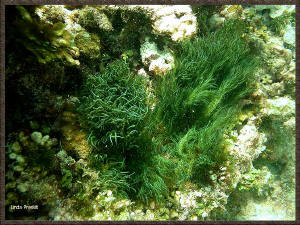|
Invasive Algae Home Red Algae Green Algae Brown Algae Seagrasses Glossary |
|
|||||||||
|
|
|||||||||
|
|||||||||
|
Click on picture for larger image
Bryopsis hypnoides forms delicate fronds that are part
of a diverse, highly competitive intertidal community. This species may be
more competitive in areas with high |
|
||||||||
|
Description Plants in filamentous tufts, to 10 cm tall, branching in irregular, scattered pattern. Primary axes highly branched. Fronds decrease in diameter with each successive division; branchlets form irregularly, undifferentiated from axes, constricted at base. Apices rounded. Rhizoidal system fibrous, tightly woven. Color is dull or dark green.
Structural Features Main axes 65-140 µm diameter, branchlets 40-80 µm diameter. Apices rounded. Vegetative pennae function as the gametangia. Plants are dioecious, with male plants becoming yellowish-green and female plants turning dark green.
Habitat Common near freshwater and nutrient rich outputs. Attaches to hard substrates such as basalt, rocks, or rubble. Forms delicate fronds which move with currents.
Distribution Hawai‘i: Northwest Hawaiian Islands, O‘ahu, Maui, Kaua‘i, Lana‘i, Moloka‘i and Hawai‘i Island.Mechanism of Introduction: Indigenous to Hawai‘i. Worldwide: World-wide distribution: Australia, Atlantic Ocean, Mediterranean, Caribbean, Indian and Pacific Oceans.
Ecology/Impact Bryopsis hypnoides is usually only a small part of the biomass of the diverse, highly competitive reef flat community. Soft, feathery tufts of this alga are often found attached to rocks among species of turfs and other low growing macroalgae. Like most green algae, Bryopsis species are highly opportunistic in eutrophic condtions. Communities found near fresh water output that is nutrient rich, or where water temperatures fluctuate will have a higher biomass of the fast growing green alga.
Bryopsis species are potentially invasive. Like the troublesome Caulerpa taxifolia, the genus produces chemical defenses that are toxic to most herbivorous organisms. Therefore, if environmental conditions occur that support fast growth of this species, it may become more competitive and dominant.
|
|||||||||
|
|
|
|
References Littler, D.S. and Mark M., 2000. Caribbean Reef Plants. OffShore Graphics, Washington, D.C. Magruder, W.H. and J.W. Hunt, 1979. Seaweeds of Hawai‘i. Oriental Publ.Co., Honolulu, Hawai‘i.
|
Web Pages Virtual Herbarium. http://www.botany.hawaii.edu/reefalgae/greenskey.htm
|
